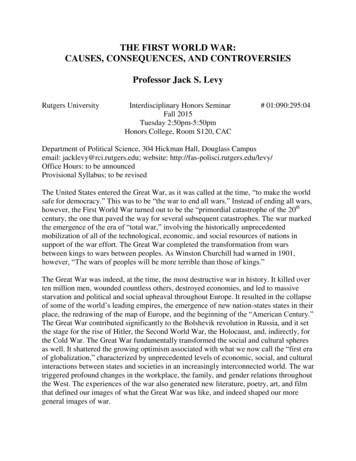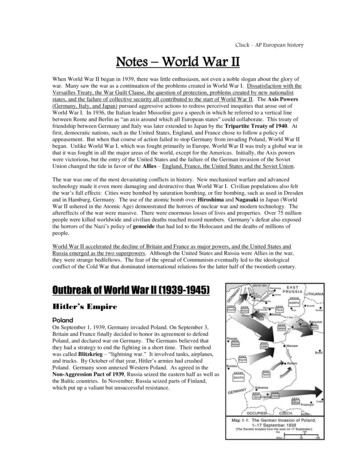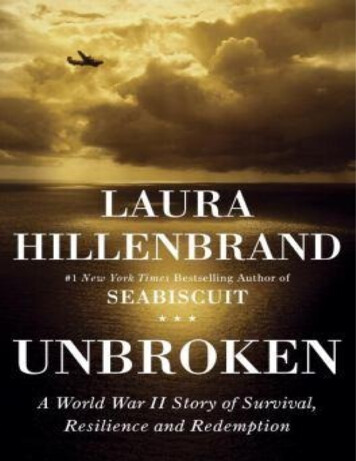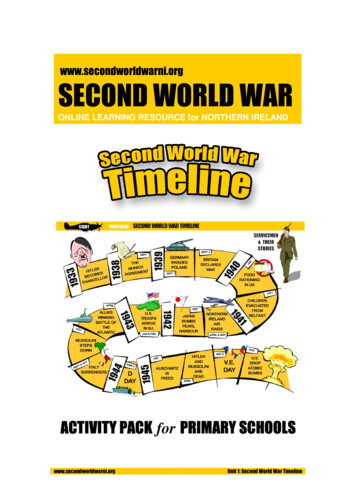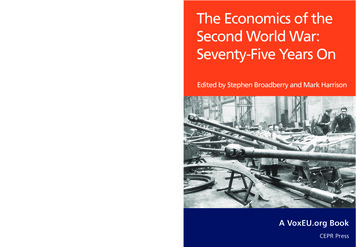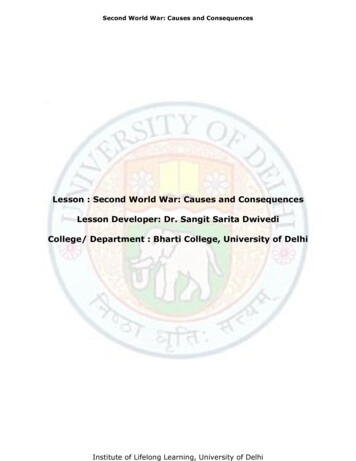
Transcription
Second World War: Causes and ConsequencesLesson : Second World War: Causes and ConsequencesLesson Developer: Dr. Sangit Sarita DwivediCollege/ Department : Bharti College, University of DelhiInstitute of Lifelong Learning, University of Delhi
Second World War: Causes and ConsequencesCONTENTS1. CAUSES OF WORLD WAR II Treaty of Versailles Rise of dictatorship in Italy and Germany Expansionist policy of the Axis Powers Failure of Disarmament Problem of National Minorities Policy of Appeasement The weakness of the League of Nations2. EVENTS LEADING UPTO WORLD WAR IIDEFENSE ALLIANCES3. THE CAMPAIGN AGAINST WEAPONS AND WAR4. OUTBREAK OF WORLD WAR II (1939)5. GERMANY’S TRIUMPH OVER WESTERN EUROPE6. WORLD WAR II ENDS7. CONSEQUENCES OF WORLD WAR II8. CONCLUSIONInstitute of Lifelong Learning, University of Delhi
Second World War: Causes and ConsequencesIntroductionHistorian John Keegan writes, “The Second World War was the continuation of the First”“and indeed [World War II] is inexplicable except in terms of the rancor and instabilities leftby the earlier conflict.”1Europe before the second world /view/map36wii.jpg/123811577/map36wii.jpg accessed on 24 January 2015The historians consider the First and Second World Wars part of the same struggle.First World War left all the European states desperate for security. Yet international conflictspersisted throughout early 1920s. After a compromise on reparation between France andGermany in 1924, the European states entered into a period of improved relations thatlasted for a decade. France and the US proposed that the nations of the world swear not toInstitute of Lifelong Learning, University of Delhi
Second World War: Causes and Consequencesstart wars of aggression. More than twenty states signed such an agreement on September1928. Eleven years after this treaty, Europe plunged into a war of much greater destructionknown as the Greater War. The terrible war happened because of the failure of the systemof collective security and the growth of international anarchy. Britain and France had goneto war to defend a threatened ally and to stop the spread of fascism. The Second World Warwas a war for democracy.Causes Of World War Ii1. Treaty of Versailles: An attempt was made at Paris Peace conference in 1919 toestablish just world order. But the treaty was drafted by victors and Germany was told tosign it. Germany raised many objections. But France had taken its revenge, Germany wasdeprived of all its overseas colonies. The treaty of Versailles had imposed humiliatingconditions on the Central powers and sowed the seeds of the Second World War.2. Rise of dictatorship in Italy and Germany: The dictatorship of the Facist party, underthe leadership of Mussolini, was established in Italy in 1922. The dictatorship of the Naziparty was established in Germany after Hitler came to power in 1933.Value addition-Know it moreSpeech of Adolf Hitler, 1930If the German people does not solve the problem of its lack of space, and if it does not openup the domestic market for its industry, then 2,000 years have been in vain. Germany willthen make its exit from the world stage and peoples with more vigor will come into ourheritage. Space must be fought for and maintained. People who are lazy have no right tothe soil. Soil is for him who tills it and protects it. If a people disclaims soil, it disclaims life.If a nation loses in the defense of its soil, then the individual loses. is only power, whichcreates justice Parliaments do not create all of the rights on this earth; force also createsrights. My question is whether we wish to live or die. We have more right to soil than all theother nations because we are so thickly populated. I am of the opinion that in this respecttoo the principle can be applied: God helps him who helps himself.Source: Völkischer Beobachter, May 7, 1930. Available ed Date: 5 November 14Institute of Lifelong Learning, University of Delhi
Second World War: Causes and Consequences3. Expansionist policy of the Axis Powers: Germany, Italy and Japan were the AxisPowers which had pursued the expansionist policy during the inter-war period. Germanybrought about the unification of the all-German speaking provinces by the annexation ofAustria and Czechoslovakia. Italy annexed Ethiopia in 1936 and Albania in 1939. Japaninvaded China in 1937 and occupied three-fourths of its territory by the middle of 1939.4. Failure of Disarmament: The task of preparing a plan for reduction of armaments wasentrusted to the League of Nation. No success could be achieved in this area. The temporaryMixed Commission appointed by the League in 1920 could not do any substantial work. In1925 Preparatory Commission was constituted.It could not do any substantial work.Finally, a Disarmament Conference met in Geneva in February 1932 but could not reach anyagreement. In 1935, Germany declared that she was no more bound by the military clausesof the Treaty of Versailles.5. The Problem of National Minorities: The US President Wilson had advocated theconcept of self-determination but his principle could not be implemented on variousoccasions. For instance, large German minorities were in company with non-Germans inPoland and Czechoslovakia. There were Russian minorities in Poland and Rumania. Thisgave rise to feeling of insecurity among the minorities.6. Policy of Appeasement: England and France ignored the acts of aggression byGermany and Italy and succumbed to their pressure. Appeasement was started by PrimeMinister Baldwin but pursued by Neville Chamberlain in 1938. The policy of appeasementemboldened the aggressive nations.7. The weakness of the League of Nations: The League of Nations was a helplessspectator when the Axis powers committed acts of aggression due to the fact that Englandand France followed the policy of appeasement towards the axis powers. It failed tomaintain peace, to protect smaller nations against big powers. The US President Wilson wasthe principal architect of the league and promoter of disarmament. His own country couldnever become the member of the League. The League of Nations had several othershortcomings.Events Leading Upto World War IIToward Security and PeaceThe causes of the breakdown of collective security were inherent in the First World War andthe political and economic arrangements that followed. During the peace negotiations at theInstitute of Lifelong Learning, University of Delhi
Second World War: Causes and Consequencesend of the First World War, French representatives made sure that their country wouldremain safe from further German aggression. President Wilson struggled to incorporate intothe Paris treaties the peacemaking ideals he had expressed in the fourteen points. TheAllied powers concluded the Peace of Paris in June 1919. The League of Nations assembledfor the first time in Geneva without representatives from the US. The American Senate hadrejected the treaties that Wilson signed at Paris. This left the League under British andFrench domination. During most crises, the League usually played little or no role at all. Theformation of the League of Nations did not transform the international relations.Totalitarianism in Italy, Germany and Japan had posed a new threat to peace.German troops in Paris after the fall of -1940.png,Accessed on 27 January,2015Italy under the leadership of Benito Mussolini, had inaugurated the first totalitarian state in1922. Adolf Hitler became Chancellor of Germany in 1933, improved on the Italian model.Japan borrowed methods and techniques from these European powers. Totalitarianism haddeveloped in those states that had suffered defeat in the First World War. To themdemocratic processes were too slow for the reforms.Institute of Lifelong Learning, University of Delhi
Second World War: Causes and ConsequencesDefense AlliancesAt the time of the Paris peace negotiations, the US and Britain concluded an agreement withFrance. They pledged to aid France if Germany ever attacked. Months later, the Americansand British withdrew their promise of assistance. France built a new system to restrainGermany by arranging defense treaty with Belgium (1920) and Poland (1921).The Quest for Improved RelationsFrench and British leaders convened an economic conference at Genoa, Italy in April 1922.They hoped to stimulate European economic recovery by getting the Soviet government topay foreign debts left by imperial Russia. But a resolution of the economic conflict becameimpossible.The Rapallo TreatyBefore the Genoa conference ended, the Germans and Soviets revealed that they hadrecently met in Rapallo, Germany to sign a treaty of friendship and economic cooperation.The Locarno AgreementsIn 1925, European leaders held extended negotiations in Locarno, Switzerland thatproduced better results than Genoa meeting. These Locarno conferences led to a series oftreaties that ended disagreements about the location of German, Belgian, and Frenchborders. These three nations decided to accept existing boundaries. The Locarnoagreements left many international problems unsettled.The Campaign against Weapons and WarThe Disarmament CampaignIn November 1921, the US opened the Washington Conference for a consideration of navalarmaments and the issues related to Asia. The representatives of six European and twoAsian states joined the Americans for three months of negotiations to conclude twoagreements on Asian affairs and one on naval armaments. The US, Britain, Japan, France,and Italy signed the naval arms treaty. They accepted limits on the size of their heavywarship fleets and pledged not to build large vessels for ten years. These five nations metInstitute of Lifelong Learning, University of Delhi
Second World War: Causes and Consequencesfor the London Naval Conference in 1930 and agreed to put limits on smaller vessels,including submarines. The League of Nations established a commission in 1926 to preparefor a conference that would bring large group of nations to arrange limits on the full rangeof military forces. This led to a series of Geneva Disarmament Conferences that began inFebruary 1932 attended by sixty states. Negotiations came to halt in October 1933 whenHitler withdrew from the Conference.The Kellogg-Briand Peace PactAn agreement arranged by Frank Kellogg, the American secretary of state, and AristideBriand, the French foreign minister came to be known as the Kellogg-Briand Peace Pact. Thepact presented to the world in 1928 proposed that nations pledge to stop using war toachieve their goals. Every state with the power to wage war on a significant scale signedthis pact formally known as the Pact of Paris.The Resurgence of the German ThreatHitler intended to have a more powerful German military force. In the mid-1920s hepublished Mein Kamph (My Struggle), in which he gave a summary of his ideas. In January1933 he became Reich Chancellor of Germany and in August 1934, he was officiallyconfirmed as the fuhrer of a nation. The production of military equipment proceeded atgreat speed in Germany. In October 1933, nine months after Hitler became Germanchancellor, he withdrew from the Geneva arms talks and the League of Nations.Dust jacket of the book Mein Kampf, written by Adolf Hitler. .Institute of Lifelong Learning, University of Delhi
Second World War: Causes and commons/3/30/Mein Kampf dust jacket.jpegaccessed on 27 January,2015Courtesy of New York public library digital systemGermany’s Nullification of the Versailles Military LimitsHitler considered the military limitations placed on Germany by the Versailles Treaty to beeven more insufferable than League membership. In March 1935, he proclaimed thatGermany no longer recognized the Versailles arms limitations clauses. France, Italy, andBritain met to consider Germany’s response.The Remilitarization of the RhinelandThe Versailles treaty required the demilitarization of German territory on the Rhine River.Hitler ordered troops to return to the Rhineland in March 1936. The Fuehrer’s generalsopposed this move because they feared a French attack and Germany was too weak toresist. Hitler’s forces met no opposition. Hitler’s success in the Rhineland made it moredifficult for the European leaders to resist Nazi aggressiveness in future. Despite thesimilarities between Italian fascism and German Nazism, Mussolini viewed Hitler as a threatto Italian interests until 1935.The Italian Conquest of EthiopiaItaly tried to conquer Ethiopia during Europe’s imperial campaigns in Africa in the late1800s. The Ethiopian triumph over Italy’s troops in 1896 humiliated the Italians. Mussoliniwas determined to take the revenge. He also claimed that a Mediterranean-African empirewas Italy’s destiny. These incentives led to an Italian attack on Ethiopia in October 1935.Hitler supported this aggressive act, to Mussolini’s great pleasure. The members of theLeague of Nations condemned Italy and voted to impose economic sanctions. The memberstates were to stop trading with Italy so that resource shortages would force an end toaggression. The sanctions failed to have this effect because of the League’s inability toprevent the shipping of petroleum to Italy. Ethiopia fell in May 1936. Mussolini’s victoryunder these circumstances marked the failure of the League of Nations.Institute of Lifelong Learning, University of Delhi
Second World War: Causes and ConsequencesRome-Berlin AxisIn 1936, Mussolini and Hitler supplied military aid to Franco and the fascist rebels to destroythe Spanish rebels. This assistance made it possible for Franco to win by 1939. SovietRussia sent advisers to assist the Spanish government. However, it had no significantinfluence on the outcome of the civil war in Spain. Negotiations between Italy and Germanyconducted in October 1936 resulted in a strengthened Fascist relationship called “the RomeBerlin axis.” Mussolini announced this association on 1 November 1936. In November 1937,Fascist Japan joined with Italy and Germany to form the Anti Comintern (anti-Communist)PactHitler’s Annexation of AustriaHitler’s doctrines emphasized the Nazi plan to build a German empire (Reich), the third inhistory. This required that the nation had to expand. Since the early 1920s, the Fuehrer hadproclaimed that enlarged Germany had to include Austria, his homeland.Dismantling of the Austrian border post by the German and Austrian border s/a/a2/Bundesarchiv Bild 137049278%2C Anschluss %C3%96sterreich.jpg Accessed on 27 January 2015Institute of Lifelong Learning, University of Delhi
Second World War: Causes and ConsequencesAustria was small and her population was largely German. Her strategic position was on theroad to Italy and on the flank of Czechoslovakia. Hitler began his annexation campaign in1938 by ordering Austrian Chancellor Kurt von Schuschnigg to allow the revival of the partyand add Nazis to the Austrian cabinet or face a German invasion. Schuschnigg submitted tothese demands but announced plans for a plebiscite in which Austrians would vote onwhether to remain free and independent. Hitler prepared to invade and told Schuschnigg toturn the government over to Arthur von Seyss-Inquart, an Austrian Nazi. When Britain andFrance refused to assist Schuschnigg, he resigned and Seyss-Inquart became chancellor.The new leader invited German forces to establish order. Hitler’s troops marched in, andAustria merged with Germany on 13 March 1938. While Britain and France held conferenceswhich were of no use, Germany had added seven million people to her strength.World War II saw the new application of many new technologies by military forces on allsides of the conflict, and some of them had a profound impact on the war. The airplane inparticular became a fundamental instrument of war and changed the way many battleswere fought. Much the same may be said of the aircraft carrier, which became crucial to theUnited States after its battleships were lost at Pearl Harbor. As a result of thesedevelopments, the Battle of Britain in 1940 marked the first time in history when air poweralone determined the course of a major battle, and the Battle of the Coral Sea in 1942 wasthe first naval battle in history fought exclusively in the air, by carrier-based planes. Bothsides also realized the effectiveness of radar as a way of warning against approachingenemy planes. Germany experimented with new missile technologies as well as both jetand rocket-powered aircraft, but none of these projects was perfected in time to change theoutcome of the war.Although the majority of these new technologies had an effect on the war, they generallywere created by one side in response to similar technologies being developed by the otherInstitute of Lifelong Learning, University of Delhi
Second World War: Causes and Consequencesside—the net effect of which was to balance out the new power these technologies offered.The notable exception was the atomic bomb, which the United States developed in secretfrom 1942 to 1945 and which Japan had no way to counter at the time. Indeed, Japandeclared its surrender just days after the bombs were dropped on Hiroshima and Nagasakiin August 1945.The Czechoslovakian CrisisThe Sudetenland, a region in Czechoslovakia, stretched around the border next to Germany.Most of the Sudetenland’s population was ethnically German. In March 1938, Hitler inducedthese Germans to begin a campaign for complete control over government withinCzechoslovakia. Hitler expected a Czech refusal, which could be used as an excuse toinvade. As the Czech government tried to resolve the conflict with the Sudeten Germans,Hitler gathered his forces for an attack. The Czech had two defense treaties that promisedthem protection. One required France to aid Czechoslovakia if any aggressor invaded. Theother obligated the Soviets to assist in Czech defense whenever the French did. Pressurefrom Britain convinced France not to aid Czechoslovakia. Without French support, theCzechs could not expect assistance from the Soviets. In early September 1938, the Czechgovernment surrendered authority over the Sudetenland to its German inhabitants. Hitlerpresented more demands until late September 1938, when the Fuehrer insisted on theannexation of the Sudetenland to Germany and the surrender of all fortifications in theregion. Czechoslovakia refused to comply.Appeasement PolicyNeville Chamberlain, the British prime minister beginning in 1937, had encouraged repeatedCzech surrenders to Germany. He believed that Europe could avoid war by a policy ofappeasement. In Chamberlain’s opinion, the Fuehrer would not insist on anything else, onceInstitute of Lifelong Learning, University of Delhi
Second World War: Causes and Consequencesthe German regions were added to the Nazi state. Edouard Daladier, the French premier,agreed with Chamberlain and joined the policy of appeasement.The Munich AgreementOn 29-30 September 1938, Chamberlain, Daladier, Mussolini, and Hitler met in Munich,Germany to discuss the conflict over the Sudetenland. They did not invite Czech and Sovietrepresentatives to the conference. In the discussion, the three leaders offered Hitlereverything he wanted. He accepted the gift of the Sudetenland and its forts.The German Annexation of CzechoslovakiaOn their return, Chamberlain and Daladier told their citizens that the Munich agreementguaranteed “peace in our time.”2 But Winston Churchill said, “Britain and France had tochoose between war and dishonor. They chose dishonor. They will have war”. 3 It wascorrect. Thus by 1938 the system of collective security had completely failed. In mid-March1939, less than six months after the Munich conference, Germany took control of all Czechterritory under the pretense of stooping political disorder.The territorial disputes indicated that Hitler might threaten Poland. Britain and Francetried to enforce peace by vowing to defend Poland against aggression. They presentedguarantees against attack on Greece and Rumania. Britain concluded an alliance withTurkey.The Nazi-Soviet PactFascists supported capitalism and fought communism. This tendency of fascist anddemocratic governments in West Europe to have hostile attitude toward communism madeit difficult for British and French leaders to cooperate with the Soviets. Britain and Francebecame more hostile toward Germany after the fall of Czechoslovakia. The German andSoviet dictators realized that they could benefit by joining hands. Germany and the SovietUnion wanted to regain territory lost to Poland at the end of the First World War. Stalin sawan additional advantage in reaching an understanding with Hitler. On 24 August 1939Institute of Lifelong Learning, University of Delhi
Second World War: Causes and ConsequencesGerman foreign minister and Soviet foreign minister announced the signing of a ten-yearTreaty of Non-Aggression. This pact contained public pledges that Germany and the SovietUnion would neither attack each other nor join any group of nations hostile to thesignatories of this agreement. Secretly, Stalin and Hitler arranged for the Soviets to annexLatvia, Lithuania, Bessarabia (part of Romania), and a section of Poland. This agreementremoved the last barrier to Hitler’s attack on Poland.Outbreak of World War II 1939The Nazi and Soviet Campaigns in Northeast Europe: The Conquest of PolandThe Germans tested for the first time the tactics of Blitzkrieg “lightning war” against Poland.From Northern Germany to the forests on the Russian border there was scarcely a naturalobstacle to stop an invading army. On 1 September 1939, an attack by Germany on Polandbegan the warfare that lasted six years and spread around the globe. Twelve hours afterHitler had attacked Poland, he replied to Roosevelt that he had, “left nothing untried for thepurposeofsettlingthedispute inafriendly manner.”4PolandfoughtaloneasCzechoslovakia was dismembered and Russia had a non-aggression pact with Germany.The German invasion of Poland brought French and British declarations of war on theNazi state within two days. Italy did not enter the war at this time. Within less than twoweeks, war tactics subdued most of Poland. Alarmed by this formidable military display, theSoviets rushed into their assault on eastern Poland in mid-September. On 17 September,Stalin ordered the invasion of Poland by the Red Army. After a week, Polish resistanceended with the capture of the capital city of Warsaw. The Polish government surrendered.The Soviet Union and Germany each took about half of the conquered territory. Hitlerannexed the former Free City of Danzig, the Corridor, and a number of other districts in theWest. Stalin annexed Eastern Poland up to the frontier that Lord Curzon had originallyproposed in 1919. Soon after the Soviets secured their holdings in Poland, they forciblyannexed the Baltic States (Estonia, Latvia, and Lithuania) to provide an expanded securityzone in the northwest.Institute of Lifelong Learning, University of Delhi
Second World War: Causes and ConsequencesGermany’s Triumph over Western EuropeAs Stalin made an effort to seize security zones around the Baltic coast, Hitler prepared totake all of West Europe. Since Hitler did not attack France and Britain, Chamberlainresponded in kind.The Phony WarBritain and France were at war with Germany beginning in September 1939. But for sixmonths, France and Britain were not attacking when German armies were fighting inPoland. During this drole de guerre, Sitzkrieg, “phony war,” was not a war, it was theblockade. Britain strengthened its military force. After the Great War, France had built theMaginotline, a series of forts facing Germany. The French did nothing to increase thenation’s military power from September 1939, until April 1940.The War in FinlandThe Winter war between Finland and the Soviet Union was fought apart from the mainconflict. By the Nazi-Soviet Pact, Stalin obtained from Hitler a free hand to strengthen hisdefensive position by expanding into Poland and toward the Baltic.The USSR attempted to make its borders north of Leningrad more secure by taking Finnishterritory north of Leningrad. The Finns refused to allow this annexation and prepared forwar. From November 1939 and March 1940, Finland fought the USSR. When the French andBritish were ready to help Finland, it had already succumbed to Soviet arms. The Sovietarmy broke through, and Finland sued for peace. The peace treaty gave Stalin – theKarelian Isthmus, the city of Viipuri, and a naval base at Hango. The settlement with Finlandprovided protection for the Leningrad.The Fall of FranceNorway would offer a threat to Britain if it fell into German hands. It could provide theGerman navy with protected submarine bases. The British sought to prevent this. On 8 April1940, the British and French announced that they were about to mine Norwegian territorialwaters to cutoff the passage of German ships.5 The Norwegians protested this violation ofInstitute of Lifelong Learning, University of Delhi
Second World War: Causes and Consequencestheir neutrality. When the Nazi forces launched the Westward assault on 9 April 1940, theyseized Denmark on the first day and conquered Norway within three weeks. By 20 April,when the Anglo-French expeditionary force arrived, it was too late. After some days Germanarmies invaded the Netherlands and Belgium. The Dutch fell on 14 May and Belgium fell tendays later.The French SurrenderAs Hitler’s armies approached Paris, Mussolini decided to declare war on France and Britain.The Germans needed no help in France. They took Paris by mid-June and continued towardsSouth. France surrendered on 22 June. The Germans imposed their will on the vanquishedin that very same railroad car at Compiegne in which Foch had handed his armistice termsto the Germans in November 1918.6 Although the Germans occupied and directly controlledmost of France, they left a southwestern quadrant of the country under a puppetgovernmentInstitute of Lifelong Learning, University of Delhi
Second World War: Causes and ConsequencesFrench troops surrender in Second World ons/2/2f/Bundesarchiv Bild 1210427, Franz%C3%B6sische Kriegsgefangene.jpg accessed on 28 January 2015The fall of France came as the greatest shock to the Western democracy. The fall ofFrance in June 1940 left Hitler supreme in the continent. His armies had conquered sixnations. Finland, Sweden, and Switzerland remained neutral and posed no threat toGermany. Only Britain and the USSR stood between Hitler and the conquest of entireEurope.The Battle of Britain and Hitler’s First DefeatChamberlain resigned and Winston Churchill became the British prime minister in May 1940.He denounced the policy of appeasement and demanded more powerful and speedyInstitute of Lifelong Learning, University of Delhi
Second World War: Causes and Consequencespreparation for war. The intervention of the United States or the Soviet Union could giveBritain a hope of victory. Britain’s Royal Air Force and German Air Force fought the Battle ofBritain until November 1940. A few thousand intrepid pilots of the RAF had won the Battle ofBritain. As Churchill expressed, “Never in human history have so many owed so much to sofew.”7After May and June 1941 Germany gave up the plan to invade Britain and turned itsforces against the Soviet Union. This war cost the Nazis dearly which weakened the GermanAir Force. Soon after the Battle of Britain began, Mussolini decided to expand his empire. ByDecember the Italians were losing on all the southern fronts.The Conquest of Greece and YugoslaviaOn 28 October, Mussolini attacked Greece from bases in Albania. By December, the Greekshad chased them back into the mountain of Albania. Stalin continued the restoration ofRussian frontiers of 1914 by seizing Bessarabia from Rumania and annexing the BalticStates. He undertook to protect Rumania against Russia. In return he ordered theRumanians to give up additional territory to their neighbours, half of Transylvania toHungary and a smaller area of Danube to Bulgaria. In March 1941, the weak Yugoslavgovernment gave in to Hitler’s demand for subserviency. Yugoslavs chose to fight ratherthan succumb. On 6 April the German attack began both from the North and from Bulgaria.In eleven days the Germans conquered Yugoslavia. Greece too had been invaded. A weekafter the capitulation of Yugoslavia, Greece signed an armistice. But the Battle of Britain andthe wars started by Mussolini had reduced Germany’s military resources which forced Hitlerto delay the invasion of the Soviet Union.The End of the Nazi-Soviet Pact: A Soviet Triumph and Soviet CollapseAs Hitler had announced in Mein Kamph, he was resolved to eliminate the power of Russia.The Nazi-Soviet non-aggression pact (1939) in no way reduced Hitler’s commitment. Russiahad moved in to create a defensive barrier in eastern Poland, Finland, the Baltic States andBessarabia. Germany had extended its influence to Hungary, Bulgaria, and Rumania andInstitute of Lifelong Learning, University of Delhi
Second World War: Causes and Consequencessmashed its way into Yugoslavia and Greece. The non-aggression pact was a “marriage ofconvenience” to be broken when it suited. On 12 November 1940, foreign minister Molotovarrived in Berlin. The two did not reach a settlement. In late June 1941, a Nazi force stoodfor Operation Barbarossa, the invasion of the Soviet Union. Hitler had several alternativesbefore him: to wage an all-out war against Great Britain, to seize the Mediterranean landsand march into the M
2. events leading upto world war ii defense alliances 3. the campaign against weapons and war 4. outbreak of world war ii (1939) 5. germany’s triumph over western europe 6. world


